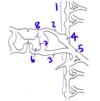FDN2_SM_WK3_Nervous Flashcards
Where are the cell bodies of all neurons in the CNS?
Grey Matter
Grey matter surrounds the cerebral cortex and makes up the inner core of the spinal cord
What does grey matter contain?
Cell bodies of CNS neurons
Where can grey matter be found?
The cerebral cortex of the brain
The inner core of the spinal cord
Which number(s) point(s) to the grey matter in the spinal cord?

2, 3, 4
Which number(s) point(s) to the white matter in the spinal cord?

1
What does white matter contain?
Myelinated axons (cell processes) in the CNS
Where are the cell bodies of somatomotor neurons found?
Ventral horn of the spinal cord (in the grey matter)
What is a ganglion?
Any cell body located outside of the CNS
Where are the cell bodies of sensory neurons?
Dorsal Root Ganglia
Exception: Visceral scensory nerons in the vagus nerve have cell bodies in the brain (innervate the thorax and abdomen)

Where do sympathetic nerves exit the spinal cord?
Lateral horn from T1-L2
What cell bodies are found in the ventral horn?
Cell bodies of somatomotor neurons
What cell bodies are found in the dorsal horn?
Interneuron cell bodies
What cell bodies are found in the dorsal root ganglion?
Sensory cell bodies (general and visceral)
*Except visceral neuron cell bodies in the vagus nerve*
Which sensory cell bodies are NOT found in the dorsal root ganglia?
Cell bodies of visceral sensory neurons in the vagus nerve
- These signals will be coming from the abdomen and thorax
What is the difference between the ventral and dorsal horns?
Besides location, the ventral horn contains mostly cell bodies of efferent neruons, while the dorsal horn contains mostly cell bodies of interneurons

What is the difference between the ventral root and the ventral ramus?
The ventral root contains motor (efferent) neurons on their way out of the ventral horn to the rest of the body
The ventral ramus is a branch of a mixed spinal nerve that contains sympathetic, sensory, and somatomotor neurons that innervate the front and sides of the body

What is the difference between the dorsal root and the dorsal ramus?
The dorsal root contains sensory (afferent) neurons on their way into the spinal cord to synapse with an interneuron in the dorsal horn
The dorsal ramus is a branch of a mixed spinal nerve that contains sympathetic, sensory, and somatomotor neurons that innervate the back of the body

What makes up the Central Nervous System CNS?
The brain and spinal cord
(All cells with cell bodies in the brain and spinal cord)
What makes up the Peripheral Nervous System (PNS)?
Cranial and spinal nerves, autonomic nerves in the gut
Any neuron with a cell body outside of the CNS
What cell bodies are found in the sympathetic trunk?
Cell bodies of post-synaptic sympathetic neurons
What cell bodies are found in the lateral horn?
Cell bodies of presynaptic sympathetic neurons, found in lateral horns from T1-L2
Where would you find the cell body of a postsynaptic sympathetic neuron?
In the sympathetic trunk OR the collateral ganglion
Sympathetic trunk for anything except the thoracic and lumbar splanchnic nerves (Cardiopulmonary splanchnic neurons have cell bodies in the sympathetic trunk)
Collateral ganglion for neurons in the thoracic and lumbar splanchnic nerves
Which division of the nervous system is considered “voluntary”?
Somatic
What kind of nerves make up the somatic nervous system?
Spinal nerves and cranial nerves




































